
MTH Encyclopedia
| |
||||
Crawl Space Fans (middle units only)
If you own or live in a middle unit, you probably have wondered
about the fan that's in the foundation vent next to your front door.
Because middle units only have foundation vents in the front, there's
no possibility of air "flow-through" to keep the crawlspace
dry. Humidity buildup there could cause mold or mildew, which are
hazardous to health, and/or rot, which is hazardous to the building.
To prevent problems, the Corvallis Building Code requires that fans
ventilate the crawlspaces.
Once a month, please listen at the fan exit to make sure the
motor is running. If it isn't, please call your heating contractor
(Middleton, Hendrix, etc.) to have it repaired.
Pest & Rodent Mitigation
Some owners have reported rodents gaining access within their
units rquiring professional pest removal. The pest control company
reports
that some rodents are entering buildings through a chase placed in
the building foundations created at the time of construction similar to
those pictured here. The purpose of the chase is to allow for
subsequent access for utiliy lines from outside to the interior crawl
space.
Pest control mitigation has consisted of sealing these access points
from penetration by rodents. Pest control is fully the responsiblity of
individual owners and not the Association. This example is offered
for informational purposes only.
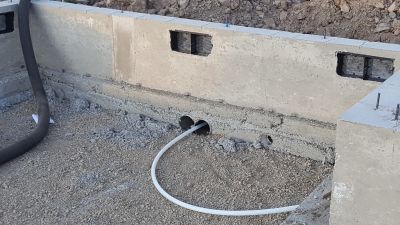
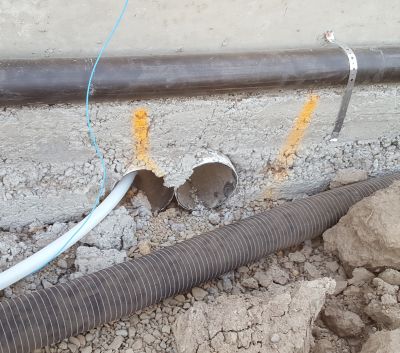
Detention Ponds off 29th and Shooting Star
There are two detention ponds (catchbasins or drainage ponds) abutting the Meadows, one between our buildings and 29th St, and one just east of the dead end of NW Shooting Star.
The 29th St catchbasin has a complicated maintenance arrangement. The Meadows irrigates it. The Park at Timberhill does the landscape maintenance. And the Timberhill Corporation (owners of the Meadowridge development at the top of 29th St) is responsible for keeping the vegetation in the pond under control); when all lots in Meadowridge have houses on them, responsibility will transfer to the Meadowridge HOA. If you are concerned about the state of the vegetation in the catchpond, we have found that the easiest remedy is to contact the City of Corvallis, who will register the complaint and notify Timberhill Corporation. Contact information: email Weed.Abatement@corvallisoregon.gov or call 541-766-6973.
The NW Shooting Star catchbasin is a protected wildlife sanctuary. The vegetation is left in its natural state, wildlife must not be disturbed, and no tresspassing is allowed within the fence.
Dryer Vent Problem
If lint builds up in the dryer vent, condensation can cause serious damage to the laundry room floor and walls. Owners and residents are urged to have their vents inspected and cleaned. Read the details and instructions (opens in new window).
Fireplace Health Issues
Introduction: Meadows at Timberhill condos have "ventless" gas fireplaces. Although these units add heat and ambiance to your home, few homeowners realize that they also pose some potential health risks.
The Equipment: Ventless gas fireplaces release all combustion products directly into the rooms where the units are installed. "Ventless" is a misnomer; these fixtures should actually be called "room-vented" fireplaces, since that is truly what they are. Traditional vented fireplaces are equipped with a flue that vents to the outdoors, saving humans and their pets from exposure to the bulk of the carbon monoxide (CO) and airborne particulates created by the natural gas. Some cities and states (California, Wisconsin and Montana and parts of Colorado, New York City) as well as all of Canada have outlawed their use.
The Health Risk: Ventless fireplaces vent toxic carbon monoxide (CO) into the room. They also release very high levels of water vapor (up to 8 gallons of water per day with continuous use), which can lead to mold growth and a variety of other moisture-related building problems. Mold can be a serious health hazard (especially here in Oregon) for at-risk individuals, and it can damage fabric, photographs, books and building materials.
The American Lung Association (ALA), the Center for Disease Control (CDC), the Environmental Protection Agency (EPA) and the Mayo Clinic have all issued warnings about the use of ventless fireplaces. These warnings are directed particularly with regard to pregnant women, the elderly, those with pre-existing cardio-vascular difficulties, and small children.
The Workaround: You must leave a window open when using the fireplace, to vent both the hazardous gases and the water vapor. Unfortunately, this defeats the purpose of using the unit to heat the home! These units were not meant to be used as a primary source of home heat given their release of water vapor and other contaminates, yet many homeowners do just that.
Permanent Solutions: For homeowners interested in alternatives to the ventless fireplace, there are two possible options. If your fireplace is on an external wall, it may be possible to replace your vent less fireplace with a vented gas fireplace. You could also replace it with an inexpensive electric fireplace. Contact your local licensed heating contractor or fireplace installer for more information. Please be aware that any modifications to the building envelope (e.g., installing a vent through the wall) requires Architectural Review Committee approval.
(Our thanks to Dr. Tamina Toray for researching and writing this section.)
Flooring Material
The laminate flooring used at The Meadows is manufactured by Shaw. It is the "Alpine Maple" pattern, color #00116. The original construction used Lot #100. Plank size is 7.86" x 47.56".
Furnace Filters
Changing your furnace filters at least once a month will lower your bills and keep your house warmer. But where is the filter, and where do you buy more?! Your filter is located behind the white grille in your upstairs hallway ceiling. Removing two screws will release the grill and reveal the filter.
The filters are an unusual size (24" x 14") that can't be found at K-Mart, Bi-Mart, or other likely places. Go to Robinette's Hardware, downtown on the corner of 2nd and Adams near the Post Office, or to Home Depot. They have a variety of different types ranging in price from $1.50 to $15.00.
Interior paint
The original interior paint in all Meadows at Timberhill units is available at Sherwin-Williams on 9th St. It is ProMar 400, color Canvas Tan, in eggshell for most rooms and semi-gloss for bathrooms.
Satellite Dishes
Satellite TV is increasingly popular, but there is a downside: a dish must be mounted to the outside of your home, BUT NOT WHERE IT CAN BE SEEN FROM THE STREET. Please read section 7.11 of the Meadows at Timberhill CC&Rs for the official text.
Please remember that a satellite dish REQUIRES an
ARC approval before
you install it. Most approvals are granted easily, but for your protection and that of the
Association and your neighbors, the plan must be reviewed.
The Association is very concerned about possible roof leaks caused by improperly installed or neglected satellite dishes. For
this reason, dishes must be mounted on the white fascia boards just below the roofline whenever possible.
This is usually the case
for lightweight antennas (12 pounds or so) with small-footprint
mounting plates. An example of such a dish — and its correct mounting
location — is shown in the photo below:
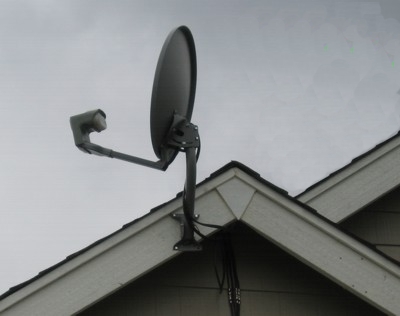
Heavy dishes (40 pounds or so) and those with large-footprint
mounting plates may be mounted on the rooftop, with mounting screws
pentrating the shingles. Installation MUST be on the part of the
roof that extends outside the walls of the building. These
installations
MUST include sealant around the screws so that water will not
penetrate the shingles. An example of the
heavy dish and its mounting location is shown in the photo below:
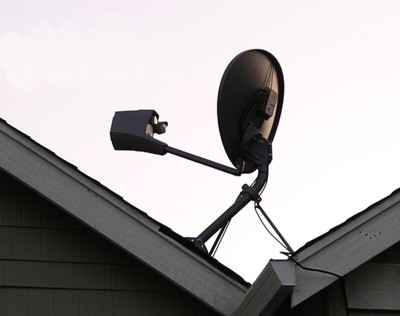
No dish may be mounted on the siding or vertical trim boards.
Any holes drilled in the siding or other exterior parts of
the building must be properly sealed to prevent water intrusion.
Maintaining
the seal is the owner's responsibility — inspect it regularly!
When an owner moves or ends the dish subscription, the dish
and cabling MUST be removed and all damage to shingles, siding, etc.
fully
repaired by a professional.
The Association will remove improperly installed dishes and repair all damage, and will bill the owner for all incurred charges.
Sprinklers
Each home in The Meadows of Timberhill has its own sprinkler system. The HOA mows your lawn, but it is up to you to water it! It is the responsibility of each home's owner and resident to ensure that their sprinkler controller is working properly, and that it is programmed to maintain the grass's and shrubbery's health and appearance. The owners and residents must also notify our contractor Fleming Properties of any non-working sprinkler heads or leaks. (The HOA will maintain the pipes, valves, and heads, and will ensure yearly backflow device testing is conducted to meet City of Corvallis ordinances.)
You can download a one-page summary instruction sheet for your sprinkler timer. It will help you get the system going properly without having to wade through the manual. You also can view the whole manual for the Nelson 8100 sprinker timer that originally came with your home.
If you are having problems with your sprinklers, try this comprehensive troubleshooting procedure. If your sprinkler heads, pipes, or valves are broken or malfunctioning, you must inform Fleming Properties so that repair can be initiated. If your sprinkler controller is broken or malfunctioning, you must arrange for the repair yourself. (Sorry, but the HOA or Board cannot recommend any specific vendors.)
Note: The rear sprinklers of homes without front driveways (i.e., all homes except those on the east side of Morning Glory) are a special case. While they use the home's own water, they are controlled by the sprinkler timers in the nearest end unit. So if your rear sprinklers are not working, you may wish to ask your end-unit neighbor to check their controller.
Trash, recycling, and glass pickup
Republic Services picks up trash and recycling every Tuesday. All non-glass recycling goes into the new tan recycling carts. Please put the carts out only when they are full or getting heavy, to make the pickup process more efficient. (By default, you will get a 65-gal cart — about the size of a yard debris cart — UNLESS you request a smaller one — 32 gal or 45 gal. You may call Republic Services at 754-0444 to request a smaller cart.)
Glass recycling goes into one of the old-style plastic bins. Glass will be picked up only on the first Monday of each month.
Yard waste pickup (for those with yard waste containers) is every other Monday. Between the first week in November and the end of the year, they will pick up leaves piled in the street (keep them 18" from the curb to allow water to drain). For exact dates, call Allied Waste at 754-0444.
The MTH CC&Rs require that trash cans, recycling containers, and yard waste containers be stored out of public view, except for the night before and day of pickup. Containers left out on a chronic basis may result in a fine.
Washing machine hoses
Just a reminder to replace your washing machine water hoses at least every five years. This goes for both rubber and steel braid cables, and for both hot and cold hoses. If a hose breaks, there is nothing to stop all that water pouring into your house, so it's very cheap insurance.
Draining Your Outside Faucets
WARNING!
Failure to winterize your faucets could result in serious damage to the interior or exterior
of your home and possibly your neighbor's. Repair of negligent damage will be at YOUR EXPENSE, not the Association's!
- Remove garden hoses from the faucets. Store them in your garage for the winter.
- Locate your faucet shut-off valves. Every outside faucet will have its own shut-off valve, which looks like
the one in the picture below. Your back faucet valve is probably above your water heater, and your front faucet valve
is probably in the storage cupboard under the stairs.
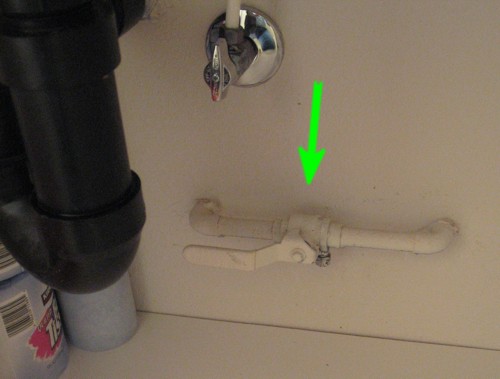
- Close the valve. Rotate the lever clockwise until it is at right angles to the pipe, as shown in the picture below.
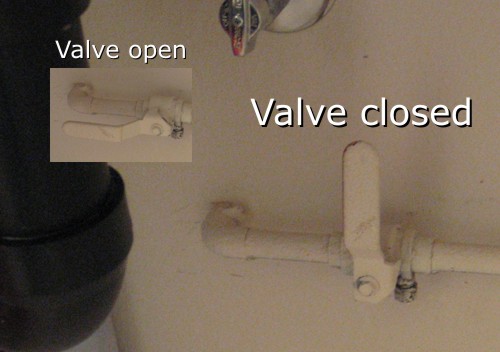
- Open the outside faucet. The water will surge out, and will then stop flowing. (If the water keeps flowing, you
picked the wrong outside faucet for the shut-off valve you closed.) Leave the faucet open until the spring.
- Locate the brass drain nut on the shut-off valve. The nut will be under the valve body, as shown in the picture
below.
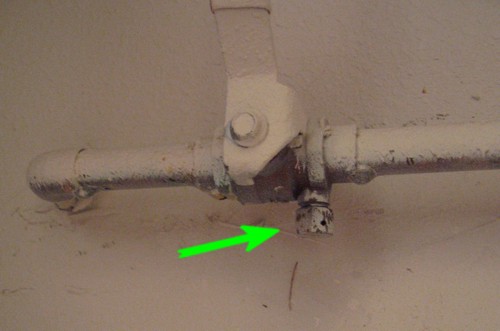
- Place a bowl under the shut-off valve. The pipe still contains as much as two quarts of water, so choose a bowl
or tray large enough to hold this amount.
- Remove the nut. Unscrew the brass nut by turning it counterclockwise; you should not need a wrench. The
remaining water in the pipe will drain into the bowl.
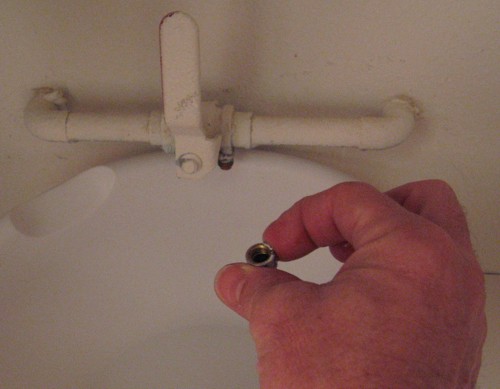
- Reinstall the nut. (Make sure the rubber pad is still inside!) Tighten it firmly with your fingers.
- In the spring, reverse the procedure. Open the shut-off
valve and watch for leaks at the brass nut; tighten it more
if needed. Go outside and shut off the faucet, which will be
flowing full-blast. Finally, go back inside and again check the
brass nut for leaks.